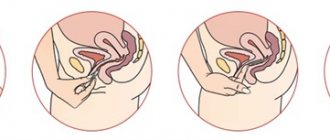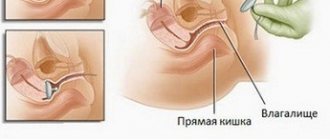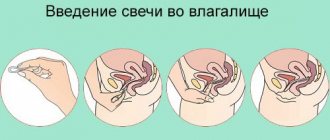What is the name of the contraceptive ring?
The vaginal contraceptive ring is produced in a single copy under the trade name “Novaring”. It is a structure made of flexible material, impregnated with hormones. The silicone product is placed in the vaginal cavity for 21 days, after which it is removed. The diameter of the ring is 54 mm and the width is 4 mm.
What is a vaginal ring?
As the name suggests, this contraceptive device is made in the form of a ring with a diameter of no more than 5.5 cm from elastic hypoallergenic materials. It bends easily, takes the required shape well and is able to maintain it for a long time.
The contraceptive vaginal ring contains microdoses of progesterone and estrogen. A complex membrane system promotes the slow release of these hormones over 21 days, influencing the menstrual cycle (see below for the therapeutic effect) and preventing pregnancy.
Composition and mechanism of action
The contraceptive is made of hypoallergenic material. Once placed in the vagina, it secretes estrogens and progestogens, which produce a contraceptive effect. The necessary effect is achieved by inhibiting the process of maturation and release of the egg. The active ingredients include etonogestrel in a volume of 11.7 mg and ethinyl estradiol 2.7 mg. The auxiliary action is performed by magnesium stearate and copolymer.
As a result of using a contraceptive, the cycle is regulated and the intensity of symptoms of the premenstrual period is reduced. The likelihood of developing iron deficiency anemia and cystic formations is excluded.
Attention! When switching to a ring from a mini-pill, injections or implants, it is recommended to additionally use barrier contraception.
What do women say?
Those who have already used a contraceptive method such as a vaginal ring leave mostly positive reviews.
Among the advantages, they note the insignificance of side effects (due to purely local effects), the need to insert a new ring only once a month, therapeutic effects (for example, reducing the pain of menstruation), effective contraception, the absence of disturbances in the vaginal microflora and associated unpleasant consequences such as candidiasis (thrush) , rapid restoration of ovulation after cessation of use.
Disadvantages: unusual use (not every woman can insert the ring on her own; some have to seek help from a gynecologist), a wide list of contraindications, the need for additional barrier methods (the ring does not protect against sexually transmitted infections).
Pros and cons of the contraceptive gynecological ring
The main feature of the silicone contraceptive ring is its ease of use. A woman may forget about the need for contraception for an entire cycle. The advantages also include:
- improving skin quality;
- high degree of protection;
- regular and painless menstruation;
- lack of discomfort during intimacy.
Despite the many advantages of contraception, it also has negative sides. The main one is the lack of protection against sexually transmitted infections. Therefore, the vaginal ring is more suitable for women who have a regular sexual partner. The disadvantages include the possibility of side effects and the body becoming accustomed to the drug.
Spiral or ring: which is better?
Many women cannot choose between an intrauterine device and a vaginal ring. The decision is made individually, together with the attending physician. The spiral is installed for a longer period - up to 5 years. The intrauterine contraceptive ring must be changed every 4 weeks. But the risk of developing side effects with it is much lower. The cost of the spiral is higher. But, if you take into account the duration of its action, it is more profitable.
Birth control ring or pills
Oral contraception is taken daily for 21 days. Unlike vaginal contraceptives, they have a negative effect on internal organs. The ring has a targeted effect, bypassing the liver, kidneys and digestive organs. Tablets are less convenient due to the need for regular use. Skipping a pill leads to a decrease in contraceptive effect.
Ring installation process
Previously, to prevent isthmic-cervical insufficiency, sutures were placed on the cervix. This procedure could only be carried out after 20 weeks, as anesthesia was required. The use of an obstetric pessary in modern gynecological practice has made it possible to solve this problem.
The most common period for ring installation is 28-33 weeks, but if there are indications, installation can be done at any time. The pessary is removed at 38-39 weeks. Childbirth usually occurs within a few days.
Important things before installation:
- get rid of infections and inflammations (especially for candidiasis), since after the introduction of the ring all pathologies noticeably worsen;
- empty your bladder;
- lubricate the ring with glycerin or clotrimazole to make insertion easier;
- if there is increased tone of the uterus or high individual sensitivity, you should take an antispasmodic half an hour before the procedure.
After emptying the bladder, the woman sits on a gynecological chair, and the doctor inserts a pre-prepared pessary through the vagina. The procedures are painless and last only a few minutes. Minor discomfort may occur.
Attention! No anesthesia is provided during ring installation.
To ensure that wearing an obstetric pessary does not cause discomfort in a pregnant woman, it is necessary to follow the doctor’s recommendations:
- physical activity is kept to a minimum, bed rest is prescribed;
- sexual contacts are contraindicated;
- Vaginal suppositories are prescribed to prevent sexually transmitted infections;
- You should regularly visit a gynecologist and undergo a preventive gynecological examination, during which the doctor will check the correct placement of the ring;
- every three weeks you need to take a smear to assess the state of the vaginal microflora.
Ring falling out
In rare cases, the cervical ring may become dislodged or fall out completely. This occurs as a result of incorrect installation or the wrong size of the pessary. If the ring is displaced, the pregnant woman will immediately begin to feel pressure, discomfort, it will be painful and uncomfortable to be in a sitting position.
It is enough to regularly visit a gynecologist to monitor the position of the device and carry out its treatment. In this case, the probability that the ring will fly off is minimal.
Removing the ring
In the normal course of pregnancy, it is carried out at 38-39 weeks of pregnancy. After the procedure, the woman’s birth canal must be sanitized. Indications for premature removal of the pessary:
- infection of the membranes and amniotic fluid;
- rupture of amniotic fluid;
- the beginning of labor;
- the need for urgent delivery (according to doctor’s indications, which are based on the condition of the mother and child).
In almost all cases, the ring helps prevent prolapse of the fetus and premature onset of labor.
Instructions for using the contraceptive ring for women
It is highly discouraged to self-prescribe contraception. The ring is prescribed by a doctor after receiving the results of a comprehensive examination of the body. A woman can insert a contraceptive into the vagina without medical assistance. Initially, you should familiarize yourself with the operating rules contained in the instructions.
If a woman switches to a vaginal product after oral contraceptives, the insertion process is carried out on the last day of the 7-day break. You can use a contraceptive after an abortion immediately after surgical curettage.
When receiving antibacterial treatment with ampicillins or tetracyclines, it is necessary to use a condom during treatment for 1 week after discontinuation of the antibiotic. This is due to a decrease in the effectiveness of contraceptives containing ethinyl estradiol. The use of candles with antifungal action slightly increases the likelihood of damage to the product.
Warning! The use of hormonal drugs causes changes in the effect of other medications. As a result, their concentration in the blood and peripheral tissues increases or decreases.
How to insert a contraceptive ring
To ensure the proper level of contraception, the vaginal ring is inserted from the 1st to the 5th day of the menstrual cycle. The product must be removed from the packaging with pre-washed hands. The most optimal position for insertion is sitting on the edge of a chair with your hips wide apart. The ring should press tightly against the cervix. To do this, insert it deep into the vagina. Thanks to the flexible material, it takes the required position independently.
What to do if your contraceptive ring falls out
If the contraceptive is installed correctly, the likelihood of it falling out is minimal. But due to inexperience, a woman may attach the contraceptive incorrectly. As a result of its loss, the contraceptive effect is not reduced if the woman managed to insert the ring back no later than 3 hours later. Before doing this, you must thoroughly rinse the product with running water.
Important! If the contraceptive is not removed for more than a month, then there is a possibility of pregnancy. In this case, you need to remove the product and take a pregnancy test.
Removal of the uterine contraceptive ring
After 21 days of wearing the contraceptive must be removed from the uterine cavity. It is important to wash your hands thoroughly with soap. After this, use your index finger to hook and pull out the product. The next step is to dispose of it.
NuvaRing, 15 mcg+120 mcg/24 h, vaginal rings, 1 pc.
If any of the diseases, conditions or risk factors listed below are present, the benefits of using the drug NuvaRing® and the possible risks for each individual woman should be assessed before she starts using the drug NuvaRing®. In case of exacerbation of diseases, deterioration of the condition, or the occurrence of any of the conditions listed below for the first time, a woman should consult a doctor to decide on the possibility of further use of the drug NuvaRing®.
Circulatory disorders
The use of hormonal contraceptives may be associated with the development of venous thrombosis (deep vein thrombosis and pulmonary embolism) and arterial thrombosis, as well as associated complications, sometimes fatal.
The use of any COC increases the risk of developing VTE compared to the risk of VTE in patients not using COCs. The greatest risk of developing VTE is observed in the 1st year of COC use. Data from a large prospective cohort study of the safety of various COCs suggest that the greatest increase in risk compared with the risk in women not using COCs is observed in the first 6 months after starting COC use or resuming their use after a break (4 weeks or more). In non-pregnant women not using oral contraceptives, the risk of developing VTE is 1 to 5 per 10,000 woman-years (WY). In women using oral contraceptives, the risk of developing VTE ranges from 3 to 9 cases per 10,000 women. However, the risk increases to a lesser extent than during pregnancy, when it is 5–20 cases per 10,000 YL (pregnancy data are based on the actual duration of pregnancy in studies; when converted to a pregnancy duration of 9 months, the risk ranges from 7 to 27 cases per 10,000 ZhL). In postpartum women, the risk of developing VTE ranges from 40 to 65 cases per 10,000 women. VTE is fatal in 1–2% of cases.
According to research results, the increased risk of developing VTE in women using NuvaRing® is similar to that in women using COCs (adjusted risk ratio, see Table 2 below). A large prospective observational study, TASC (Transatlantic Active Study of the Safety of the Drug NuvaRing® for Cardiovascular Stress), assessed the risk of developing VTE in women who started using the drug NuvaRing® or COCs, switched to NovaRing® or COCs from other contraceptives, or resumed using the drug NuvaRing® ® or COC, in a population of typical users. Women were followed up for 24–48 months. The results showed a similar level of risk of developing VTE in women using the drug NuvaRing® (8.3 cases per 10,000 YL) and women using COCs (9.2 cases per 10,000 YL). For women using COCs other than those containing desogestrel, gestodene and drospirenone, the incidence of VTE was 8.5 cases per 10,000 women.
A retrospective cohort study initiated by the FDA (US Food and Drug Administration) showed that the incidence of VTE in women who started using the drug NuvaRing® was 11.4 cases per 10,000 YL, while in women of those who started using COCs containing levonorgestrel, the incidence of VTE is 9.2 cases per 10,000 young people.
table 2
Assessment of the risk (risk ratio) of developing VTE in women using the drug NuvaRing®, compared with the risk of developing VTE in women using COCs
| Epidemiological study, population | Comparator(s) | Risk ratio (RR (95% CI) |
| TASC (Dinger, 2012). Women who started using the drug (including again, after a break) and switched from other means of contraception | All available COCs during the study1 | OR2: 0.8 (0.5–1.5) |
| Available COCs, except those containing desogestrel, gestodene, drospirenone | OR2: 0.9 (0.4–2) | |
| "FDA Initiated Study" (Sydney, 2011). Women who started using combined hormonal contraceptives (CHCs) for the first time during the study period | COCs available during the study period3 | OR4: 1.09 (0.55–2.16) |
| Levonorgestrel/0.03 mg ethinyl estradiol | RR4: 0.96 (0.47–1.95) |
1Incl. low-dose COCs containing the following progestins: chlormadinone acetate, cyproterone acetate, desogestrel, dienogest, drospirenone, ethynodiol diacetate, gestodene, levonorgestrel, norethindrone, norgestimate or norgestrel.
2Taking into account age, body mass index, duration of use, history of VTE.
3 Incl. low-dose COCs containing the following progestins: norgestimate, norethindrone or levonorgestrel.
4Taking into account age, place and year of inclusion in the study.
There are extremely rare cases of thrombosis of other blood vessels (for example, arteries and veins of the liver, mesenteric vessels, kidneys, brain and retina) when using COCs. It is unknown whether these cases are related to the use of COCs. Possible symptoms of venous or arterial thrombosis may be unilateral swelling and/or pain in the lower extremity, local increase in temperature in the lower extremity, hyperemia or discoloration of the skin on the lower extremity; sudden severe chest pain, possibly radiating to the left arm; attack of shortness of breath, cough; any unusual, severe, prolonged headaches; sudden partial or complete loss of vision; double vision; slurred speech or aphasia; dizziness; collapse, accompanied or not accompanied by a focal epileptic seizure; sudden weakness or severe numbness on one side of the body or any part of the body; movement disorders; acute stomach
Risk factors for the development of venous thrombosis and embolism:
- age;
- presence of diseases in the family history (venous thrombosis and embolism in brothers/sisters at any age or in parents at a young age). If a hereditary predisposition is suspected, before starting any hormonal contraceptives, the woman should be referred to a specialist for consultation;
- prolonged immobilization, major surgical interventions, any surgical interventions on the lower extremities or serious trauma. In such situations, it is recommended to stop using the drug (in the case of a planned operation, at least 4 weeks in advance) with subsequent resumption of use no earlier than 2 weeks after complete restoration of motor activity;
— obesity (body mass index more than 30 kg/m2);
- possibly thrombophlebitis of the superficial veins and varicose veins.
There is no consensus on the possible role of these conditions in the etiology of venous thrombosis.
Risk factors for the development of complications of arterial thromboembolism:
- age;
- smoking (with heavy smoking and with age, the risk increases even more significantly, especially in women over 35 years of age);
- dislipoproteinemia;
— obesity (body mass index more than 30 kg/m2);
- increased blood pressure;
- migraine;
- heart valve disease;
- atrial fibrillation;
- presence of diseases in the family history (arterial thrombosis in brothers/sisters at any age or parents at a relatively early age).
If a hereditary predisposition is suspected, the woman should be referred to a specialist for consultation before starting any hormonal contraceptives. Biochemical factors that may indicate hereditary or acquired predisposition to venous or arterial thrombosis include activated protein C resistance, hyperhomocysteinemia, antithrombin III deficiency, protein C deficiency, protein S deficiency, antiphospholipid antibodies (anticardiolipin antibodies, lupus anticoagulant).
Other conditions that can lead to unwanted circulatory problems include diabetes mellitus, systemic lupus erythematosus, hemolytic uremic syndrome and chronic inflammatory bowel disease (such as Crohn's disease or ulcerative colitis), as well as sickle cell anemia. It is necessary to take into account the increased risk of thromboembolism in the postpartum period.
An increase in the frequency or severity of migraine (which may be a prodromal symptom of cerebrovascular accidents) while using hormonal contraceptives may be a reason to immediately discontinue use of hormonal contraceptives.
Women using CHCs should be advised to consult a doctor if possible symptoms of thrombosis occur. If thrombosis is suspected or confirmed, CHC use should be discontinued. In this case, it is necessary to use effective contraception, since anticoagulants (coumarins) have a teratogenic effect.
Risk of developing tumors
The most important risk factor for developing cervical cancer is infection with the human papillomavirus. Epidemiological studies have shown that long-term use of COCs leads to an additional increase in this risk, but it remains unclear to what extent this is due to other factors, such as more frequent cervical smears and differences in sexual behavior, including. use of barrier contraceptives. It remains unclear how this effect is related to the use of the drug NuvaRing®.
A meta-analysis of 54 epidemiological studies found a small increase (1.24) in the relative risk of breast cancer in women taking COCs. The risk gradually decreases over 10 years after stopping the drugs. Breast cancer rarely develops in women under 40 years of age, so the additional incidence of breast cancer in women who take or have taken COCs is small compared to the overall risk of developing breast cancer. Breast cancer diagnosed in women who use COCs is clinically less severe than cancer diagnosed in women who have never used COCs. The increased risk of breast cancer may be due to both earlier detection of breast cancer in women taking COCs, the biological effects of COCs, or a combination of both.
In rare cases, women taking COCs have developed benign, and even more rarely, malignant liver tumors. In some cases, these tumors led to the development of life-threatening bleeding into the abdominal cavity. The doctor should consider the possibility of a liver tumor in the differential diagnosis of diseases in a woman taking NuvaRing® if symptoms include acute pain in the upper abdomen, liver enlargement, or signs of intra-abdominal bleeding.
Other states
Women with hypertriglyceridemia or a corresponding family history have an increased risk of developing pancreatitis when taking hormonal contraceptives.
Many women taking hormonal contraceptives experience a slight increase in blood pressure, but clinically significant increases in blood pressure are rare. A direct connection between the use of hormonal contraceptives and the development of arterial hypertension has not been established.
If a constant increase in blood pressure is observed when using the drug NuvaRing®, you should contact your doctor to decide whether it is necessary to remove the vaginal ring and prescribe antihypertensive therapy. With adequate blood pressure control using antihypertensive drugs, it is possible to resume use of the drug NuvaRing®.
During pregnancy and during the use of COCs, the development or worsening of the following conditions was noted (although their relationship with the use of contraceptives has not been definitively established): jaundice and/or itching caused by cholestasis, formation of gallstones, porphyria, systemic lupus erythematosus, hemolytic uremic syndrome, Sydenham's chorea (minor chorea), herpes of pregnancy, hearing loss due to otosclerosis, (hereditary) angioedema.
Acute or chronic liver dysfunction may serve as a basis for discontinuation of the drug NuvaRing® until normalization of liver function indicators. Recurrence of cholestatic jaundice, previously observed during pregnancy or during the use of sex hormones, requires discontinuation of the drug NuvaRing®.
Although estrogens and progestogens may influence peripheral insulin resistance and tissue glucose tolerance, there is no evidence to support the need to change hypoglycemic therapy during the use of hormonal contraceptives. However, women with diabetes should be under constant medical supervision when using NuvaRing®, especially in the first months of contraception.
There is evidence of a worsening of Crohn's disease and ulcerative colitis with the use of hormonal contraceptives.
In rare cases, pigmentation of the facial skin (chloasma) may occur, especially if it occurred earlier during pregnancy. Women predisposed to the development of chloasma should avoid exposure to sunlight and UV radiation while using NovaRing®.
The following conditions may prevent the ring from being inserted correctly or may cause it to fall out: cervical prolapse, bladder and/or rectal hernia, severe chronic constipation.
In very rare cases, women have unintentionally inserted the NuvaRing® vaginal ring into the urethra and possibly into the bladder. When symptoms of cystitis appear, it is necessary to consider the possibility of incorrect insertion of the ring.
Cases of vaginitis have been described during use of the drug NuvaRing®. There is no evidence that treatment of vaginitis affects the effectiveness of the use of the drug NuvaRing®, as well as evidence of the effect of the use of the drug NovaRing® on the effectiveness of treatment of vaginitis.
Very rare cases of difficult ring removal have been described that required removal by a medical professional.
Medical examination/consultation
Before prescribing the drug NuvaRing® or resuming its use, you should carefully review the woman’s medical history (including family history) and conduct a gynecological examination to exclude pregnancy. It is necessary to measure blood pressure, conduct an examination of the mammary glands, pelvic organs, including a cytological examination of cervical smears and some laboratory tests, to exclude contraindications and reduce the risk of possible side effects of the drug. The frequency and nature of medical examinations depend on the individual characteristics of each patient, but medical examinations are carried out at least once every 6 months. A woman should read the instructions and follow all recommendations. The woman should be informed that NuvaRing® does not protect against HIV infection (AIDS) and other sexually transmitted diseases.
Reduced efficiency
The effectiveness of NovaRing® may decrease if the regimen is not followed or if concomitant therapy is carried out.
Changes in the nature of menstruation
During use of the drug NovaRing®, acyclic bleeding (spotting or sudden bleeding) may occur. If such bleeding is observed after regular cycles with the correct use of the drug NuvaRing®, you should contact your gynecologist to conduct the necessary diagnostic studies, incl. to exclude organic pathology or pregnancy. A diagnostic curettage may be required. Some women do not bleed after the ring is removed. If the drug NuvaRing® was used according to the instructions, it is unlikely that the woman is pregnant. If the recommendations of the instructions are not followed and there is no bleeding after removing the ring, as well as if there is no bleeding for two cycles in a row, pregnancy must be excluded.
Effects of ethinyl estradiol and etonogestrel on a sexual partner
The possible pharmacological effects and extent of exposure of ethinyl estradiol and etonogestrel to male sexual partners (due to absorption through penile tissue) have not been studied.
Ring damage
In rare cases, when using the drug NuvaRing®, ring rupture was observed.
The core of the drug NuvaRing® is solid, so its contents remain intact, and the release of hormones does not change significantly. If the ring ruptures, it usually falls out of the vagina (see the recommendations in the subsection What to do if the ring has been temporarily removed from the vagina
in the section “Method of administration and dosage”). If the ring ruptures, a new ring must be inserted.
Ring falling out
Sometimes the NuvaRing® vaginal ring may fall out of the vagina, for example, if it is inserted incorrectly, a tampon is removed, during sexual intercourse, or due to severe or chronic constipation. In this regard, it is advisable for a woman to regularly check the presence of the NuvaRing® vaginal ring in the vagina. If the NuvaRing® vaginal ring falls out of the vagina, you must follow the recommendations of the subsection What to do if the ring has been temporarily removed from the vagina
in the section "Method of administration and dosage".
Impact on the ability to drive vehicles and operate machinery.
Based on information about the pharmacodynamic properties of the drug NovaRing®, it can be expected that it does not affect the ability to drive vehicles and operate machinery.
Contraindications and side effects
Vaginal and oral contraception have contraindications. The ring is no exception. It cannot be used in the following cases:
- tendency to migraine;
- baby feeding period;
- thrombosis of arteries and veins;
- allergy to components;
- diabetes;
- bleeding from the vagina of unknown origin;
- liver pathologies;
- tumor-like processes.
Side effects when using contraception are rare. Most often they affect the vaginal mucosa and manifest as a local reaction. The most common side effects include:
- inflammatory processes of the urinary tract;
- change in the nature of vaginal discharge;
- nervousness and increased anxiety;
- increase in the volume of the mammary glands;
- weight gain or loss;
- bowel dysfunction and nausea;
- dizziness and mild headaches.
When wearing the product, the likelihood of thrombosis increases. If the first signs of illness appear, the use of contraception should be stopped immediately. Among the additional consequences, doctors highlight acyclic bleeding, frequent migraine attacks and chloasma. If the placement rules are violated, the risk of rupture of the vaginal ring increases.
Advice! If side effects occur, you should immediately contact your gynecologist.
Contraindications to the use of the product
Contraindications to the use of a contraceptive ring are divided into absolute and relative.
Absolute conditions are those in which the use of the drug is unacceptable, or when these diseases appear, the drug should be discontinued. These include:
- pulmonary embolism;
- cerebrovascular diseases: history of myocardial infarction;
- angina pectoris;
- transient ischemic attack;
Relative contraindications are those health conditions in which it is necessary to assess the possible risk when using the drug. These include:
- thrombophlebitis of veins;
- diabetes;
- heart defects with damage to the valve apparatus;
- cholelithiasis;
- systemic lupus erythematosus;
- Crohn's disease and ulcerative colitis;
- diseases in which the ring is not installed correctly or there are predisposing factors to its loss (prolapse of the cervix, hernia, chronic constipation).
Doctors' opinion
Vaginal rings that protect against pregnancy are sold in pharmacies without a prescription. But this does not mean that you can use them without the permission of your doctor. Preliminary tests are taken to determine the level of hormones in the body. It is equally important to exclude the possibility of contraindications. Only after preparatory manipulations is it possible to insert a contraceptive ring.
According to statistics, a small number of patients experience headaches and weight gain when using a contraceptive. After discontinuation of the drug, health returns to normal without outside intervention. Local reactions often occur in the form of burning of the mucous membrane and changes in discharge. But in most cases, the drug is tolerated without complications for health and well-being.
Are there any contraindications?
Vaginal rings, like any medication, are not suitable for everyone. They cannot be used under the following conditions:
- Hypersensitivity to the components contained in the ring (allergy).
- Thrombosis (both venous and arterial). All sex hormone preparations suffer from this drawback: increased blood viscosity, increased risk of blood clots. With the vaginal ring, due to its predominantly local effect, this effect is slightly expressed.
- Hormonal disorders: obesity (metabolic syndrome).
- Diabetes mellitus (since the latter is accompanied by impaired microcirculation, and the drugs included in the vaginal ring promote thrombus formation, which further impairs blood supply).
- Digestive diseases: pancreatitis, hepatitis.
- Neoplasms (both malignant and benign), especially hormone-dependent tumors.
- Pregnancy and lactation.
- Uterine bleeding of unknown origin.
The use of a vaginal ring should be treated with caution in cases of pelvic organ prolapse.
Important! For uterine prolapse, special uterine rings (pessaries) are used. They should not be confused with contraceptive vaginal rings.
In addition, they are not used in the following cases:
- Thrombophlebitis (see paragraph on thrombosis).
- Anemia.
- Jaundice.
- Cholelithiasis.
- Pathology of the valvular apparatus of the heart.










